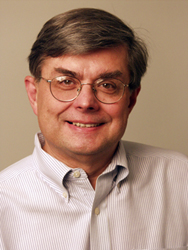Laimonis A. Laimins, PhD
 |
| Dr. Laimonis A. Laimins |
Guy and Anne Youmans Professor of Microbiology-Immunology
What are your research interests?
My research focuses on the human papillomavirus (HPV) and its role in the development of cervical cancer. I first became interested in this field of study about 20 years ago, when the association between certain types of the virus and cervical cancer was first discovered. At that time, I had just begun my career in microbiology-immunology, and was excited at the prospect of playing a role in finding ways to prevent the virus and thus prevent cervical cancer.
What are some of your current research projects?
My laboratory at the Feinberg School studies the molecular biology of HPV. These efforts are divided into two main categories: (1) examination of the how the viral oncoproteins, E6 and E7, contribute to the development of malignancy; and (2) studies on the mechanisms of controlling the viral life cycle in differentiating epithelia. To date, more then 70 distinct types of HPV have been identified, and approximately one third of these specifically target squamous epithelial cells in the genital tract. Of these, a subset including types 16, 18, and 31 have been shown to be the etiologic agents in most cervical cancers.
What is the ultimate goal of your research?
One of our goals is to understand why infection by specific HPV types contributes to the development of malignancy. For these studies, we examine the interaction of oncoproteins E6 and E7 with cellular proteins. In particular, E6 binds the p53 protein and facilitates its degradation by a ubiquitin-mediated pathway. The E7 oncoprotein binds the retinoblastoma gene product and alters its cell cycle regulatory proteins. We are examining the interaction of the E6 and E7 proteins with these cellular proteins at both the biochemical and genetic levels.
We also study the HPV life cycle. The production of HPVs is closely linked to epithelial differentiation, and progeny viruses are replicated in terminally differentiated epithelial cells. We use organotypic tissue culture systems to faithfully reproduce the differentiation program of epithelial cells in the laboratory. Using this system, the viral life cycle has been duplicated and we are currently studying the mechanisms that regulate viral DNA replication and gene expression. We hope that these studies provide insight into viral pathogenesis and the mechanisms that regulate epithelial differentiation.
In the last few years, a vaccine has been introduced that blocks infection by HPVs and prevents the development of 70 percent of future cases of cervical cancer. This is a major advance in the prevention of cervical cancer, but there is still work to be done. I hope that our efforts at Feinberg School will contribute to vaccines that will target all HPV types. It is important to note that the vaccines only work before an infection is present. Our hope is that the work we do will help in the development of a treatment for existing HPV lesions. This would be a major step in helping to prevent many more cases of cervical cancer.
What brought you to the Feinberg School of Medicine?
I came to the Feinberg School 14 years ago—and continue to enjoy my work here—because of its positive environment and the combination of great science and great colleagues.






